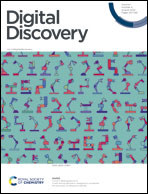Hyperconverged autonomous organic reaction infrastructure (HAORI) driven by SpecSNN, for low dielectric constant polymer research†
Abstract
We developed a hyper-converged autonomous organic reaction infrastructure (HAORI) that integrates reactions, characterization, and closed-loop optimization, driven by the Spectrum Spiking Neural Network (SpecSNN) architecture. Most of the previous data-driven autonomous lab platforms in organic reactions lack a time-resolved algorithm, which creates a gap with the optimization progress in a non-negligible time. Driven by SpecSNN, HAORI receives in situ spectroscopic feedback from the automatic synthesis unit and outputs the alternated reaction conditions considering time differences. Compared with the previous autonomous lab systems and architecture, HAORI can achieve higher efficiency and accuracy. We showed a working example in HAORI for a relative optimum reaction to synthesize a low dielectric constant polymer, producing a polymerized product with a DC (ε) from 1.32 to 2.56 and ε0 = 2.46, which is also double validated using ab initio calculations. We believe that the SpeccSNN-HAORI could be one of the next-generation autonomous lab architectures.



 Please wait while we load your content...
Please wait while we load your content...